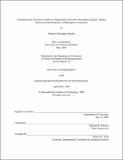| dc.contributor.advisor | Richard R. Schrock. | en_US |
| dc.contributor.author | Smythe, Nathan Christopher | en_US |
| dc.contributor.other | Massachusetts Institute of Technology. Dept. of Chemistry. | en_US |
| dc.date.accessioned | 2007-07-17T19:39:46Z | |
| dc.date.available | 2007-07-17T19:39:46Z | |
| dc.date.copyright | 2006 | en_US |
| dc.date.issued | 2006 | en_US |
| dc.identifier.uri | http://hdl.handle.net/1721.1/37838 | |
| dc.description | Thesis (Ph. D.)--Massachusetts Institute of Technology, Dept. of Chemistry, 2006. | en_US |
| dc.description | This electronic version was submitted by the student author. The certified thesis is available in the Institute Archives and Special Collections. | en_US |
| dc.description | Vita. | en_US |
| dc.description | Includes bibliographical references. | en_US |
| dc.description.abstract | Chapter 1. Using the [HIPTN3N]3- ligand ([HIPTN3N]3- = [(HIPTNCH2CH2)3N]3-; HIPT = 3,5-(2,4,6-i-Pr3C6H2)2C6H3 = HexaIsoPropylTerphenyl), green paramagnetic [HIPTN3N]V(THF) (1) can be prepared from VCl3(THF)3. Reduction of 1 with potassium graphite in ethereal solvents yields a highly sensitive red solution identified as containing paramagnetic {[HIPTN3N]VN2}-(2) via infrared spectroscopy. 1 also reacts with ammonia to form bright green paramagnetic [HIPTN3N]V(NH3) (5), 2-methylaziridine to form red diamagnetic [HIPTN3N]V=NH (7), azidotrimethylsilane to form orange diamagnetic [HIPTN3N]V=N(SiMe3) (9), propylene oxide to form purple diamagnetic [HIPTN3N]V=O (11), elemental sulfur to form dark green diamagnetic [HIPTN3N]V=S (10), and carbon monoxide to form red-gold [HIPTN3N]V(CO) (12). X-Ray crystal structures were obtained for 1, 5, and the decomposition product [HIPTN3N]VH. 5 could be converted to 7 by oxidation/deprotonation using [FeCp2]OTf/(Me3Si)2NLi. The anionic nitride "{[HIPTN3N]V=N}-" could not be obtained through deprotonation of 7, removal of the -SiMe3 group from 9, or the reaction of 1 with azides. Addition of potassium graphite to 5 resulted in decomposition rather than the formation of 2. Under the catalytic conditions used for the [HIPTN3N]Mo system, 1 produced no ammonia, while 2 and 7 yielded 0.2 and 0.78 equivalents respectively. | en_US |
| dc.description.abstract | (cont.) Chapter 2. Four dianionic diamidoamine-donor based ligands were synthesized. Two were based on a pyridine donor arm 2-(C5H4N)CH2N(CH2CH2NHIPT)2]2- ([Pyrl]2-) and 2-(6-MeC5H3N)CH2N(CH2CH2NHIPT)2]2- ([Myrl]2-), one was based on an oxygen donor arm (3,5-Me2C6H3)OCH2CH2N(CH2CH2NHIPT)2]2- ([NNO]2-), and one was based on a sulfur donor arm [(3,5-Me2C6H3)SCH2CH2N(CH2CH2NHIPT)2]2- ([NNS]2-) where HIPT = 3,5-(2,4,6-i-Pr3C6H2)2C6H3. The reaction between H2[Pyrl] with VCl3(THF)3 yielded an unstable orange product believed to be dimeric. Using H2[Myrl] yielded a stable product that on reduction with potassium graphite generated what is believed to be a dimeric, bridging dinitrogen complex, which was not catalytically active under the conditions used for the [HIPTN3N]Mo system. The reaction between VCl3(THF)3 and H2[NNO] yielded {[NNO]VCl}2 (32), which underwent ligand decomposition upon reduction with potassium graphite (33) or attempted alkylation with di-neopentyl magnesium (34). Ligand decomposition was also observed in the reaction of H2[NNS] with VCl3(THF)3 (35). X-Ray crystal structures were obtained for 32, 33, 34, and 35. | en_US |
| dc.description.abstract | (cont.) Chapter 3. Red-black [HIPTN3N]Cr (1) can be prepared from CrCl3 ([HIPTN3N]3- = [(HIPTNCH2CH2)3N]3-, while green-black [HIPTN3N]Cr(THF) (2) can be prepared from CrCl3(THF)3 where HIPT = 3,5-(2,4,6-i-Pr3C6H2)2C6H3 = exaIsoPropylTerphenyl). Reduction of {1-2} (which means either 1 or 2) with potassium graphite in diethyl ether at room temperature yields [HIPTN3N]CrK (3) as a yellow-orange powder. There is no evidence that dinitrogen is incorporated into 1, 2, or 3. Compounds that can be prepared readily from {1-2} include red [HIPTN3N]CrCO (4), blood-red [HIPTN3N]CrNO (6), and purple [HIPTN3N]CrCl (7, upon oxidation of {1-2} with AgCl). The dichroic (purple/green) Cr(VI) nitride, [HIPTN3N]CrN (8) was prepared from Bu4NN3 and 7. X-ray studies have been carried out on 4, 6, and 7, and on two co-crystallized compounds, 7 and [HIPTN3N]CrN3 (65:35) and[HIPTN3N]CrN3 and 8 (50:50). Exposure of a degassed solution of {1-2} to an atmosphere of ammonia does not yield "[HIPTN3N]Cr(NH3)" as a stable and well-behaved species analogousto [HIPTN3N](NH3). An attempt to reduce dinitrogen under conditions described for thecatalytic reduction of dinitrogen by [HIPTN3N]Mo compounds with 8 yielded a substoichiometric amount (0.8 equiv) of ammonia, which suggests that some ammonia is formedfrom the nitride, but none is formed from dinitrogen. | en_US |
| dc.description.abstract | (cont.) Chapter 4. TRAP (P(CH2CH2NH2)3), a phosphine containing analogue to TREN (N(CH2CH2NH2)3) was synthesized from PH3, but suitable conditions for arylation of the amine arms could not be found. Using the "pre-arylated" arm BrCH2CH2N(BOC)HIPT (BOC = tert-butoxycarbonyl; HIPT = 3,5-(2,4,6-i-Pr3C6H2)2C6H3) in the reaction with PH3 resulted in the isolation of H2PCH2CH2N(BOC)HIPT, but further substitution was unsuccessful. HIPTBr could be converted to HIPTNH2 using benzophenone imine and a rac-BINAP (2,2'-bis(diphenylphosphino)-1,1'-binaphthyl) supported Pd catalyst in preparation for DCC (dicyclohexylcarbodiimide) mediated coupling to tris-(3-propylcarboxylicacid)phosphine. | en_US |
| dc.description.statementofresponsibility | by Nathan Christopher Smythe. | en_US |
| dc.format.extent | 207 leaves | en_US |
| dc.language.iso | eng | en_US |
| dc.publisher | Massachusetts Institute of Technology | en_US |
| dc.rights | M.I.T. theses are protected by copyright. They may be viewed from this source for any purpose, but reproduction or distribution in any format is prohibited without written permission. See provided URL for inquiries about permission. | en_US |
| dc.rights.uri | http://dspace.mit.edu/handle/1721.1/7582 | |
| dc.subject | Chemistry. | en_US |
| dc.title | Vanadium and chromium complexes supported by sterically demanding ligands : studies relevant to the reduction of dinitrogen to ammonia | en_US |
| dc.type | Thesis | en_US |
| dc.description.degree | Ph.D. | en_US |
| dc.contributor.department | Massachusetts Institute of Technology. Department of Chemistry | |
| dc.identifier.oclc | 131218702 | en_US |
